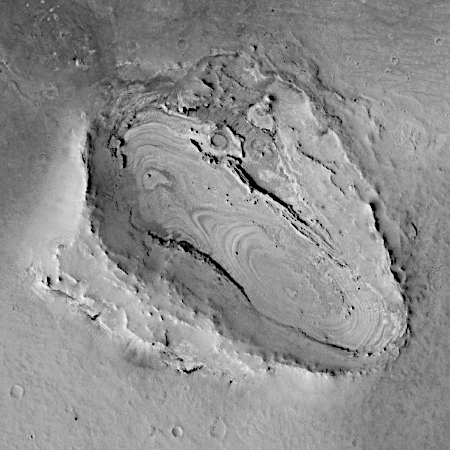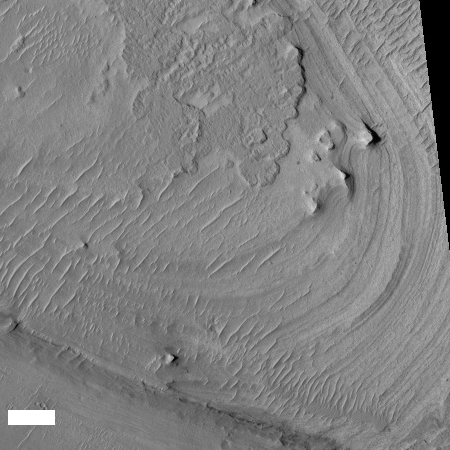What might be the weirdest crater on Mars
Cool image time! The picture to the right is taken from a global mosaic created from images taken by the wide-view context camera on Mars Reconnaissance Orbiter (MRO). The original source image was probably a photograph taken on February 15, 2020.
I normally begin with an image from MRO’s high resolution camera, but the only images that camera took of this crater did not show it entirely. This context camera shows it in all its glory, what to my eye appears to be one of the weirdest craters I’ve seen on Mars.
First, note its oblong shape — 5.5 miles long and 3.7 miles wide — which appears to narrow to the southeast. It certainly appears that if this crater was caused by an impact, the bolide came in at a very low angle from the northwest, plowing this 700-foot-deep divot as it drove itself into the ground. Research has shown that an impact has to come in almost sideways to do this. Even at slightly higher angles the resulting craters will still appear round.
But wait, there’s more!
For the overview map showing the location of this crater, go to my cool image yesterday. It was just to the west of that featured image in the southern cratered highlands near the equator. I noticed it while preparing that image, and I immediately decided it was so weird I had to highlight it today.
The image to the right is a cropped and sharpened section taken of this crater by MRO’s high resolution camera on January 13, 2007. It focuses on the southwest end of the crater to get a closer look at the many concentric interior layers seen in the wide picture above. Though the layers strongly resemble glacier features found in many craters in the icy mid-latitudes, these layers are not glacial. This location is deep within Mars’ dry tropics, only about 300 miles north of the equator. There is no near surface ice here.
Instead, what I think we are looking at are the left-over remnants of either ice or liquid water that once filled this crater, but is now long gone. The layers represent the repeated cycles of filling and draining, with each filling depositing wet dust (mud) on the edges. Because the amount of water on Mars has been declining over time, each time the crater filled, it filled less, which is why the layers form this terraced pattern.
As I noted yesterday, researchers have found evidence in this particular region suggesting that springs of water once existed here in many craters. This adds weight to my hypothesis that these layers are evidence of a past lake.
In fact, this crater and this evidence of past liquid water made this crater one of the potential landing sites that scientists considered for the rover Curiosity. I know this because the science team labeled this 2007 high-resolution picture “Proposed MSL Site in Meridiani”, with “MSL” for Mars Science Laboratory (the official name for Curiosity) and Meridiani the name of this region.
In the end the scientists decided to send Curiosity to Gale Crater instead, on the other side of the planet. This region however very clearly still intrigues planetary scientists, considering the number of follow-up images I have posted. In fact, in 2020 they used MRO to take a second high resolution photo of this particular crater, to create a stereo image in order to better map its topography.
Mars is truly strange. It will be wonder to explore for the first colonists, for many generations. This particular place will likely be one of those wonders.
On Christmas Eve 1968 three Americans became the first humans to visit another world. What they did to celebrate was unexpected and profound, and will be remembered throughout all human history. Genesis: the Story of Apollo 8, Robert Zimmerman's classic history of humanity's first journey to another world, tells that story, and it is now available as both an ebook and an audiobook, both with a foreword by Valerie Anders and a new introduction by Robert Zimmerman.
The print edition can be purchased at Amazon or from any other book seller. If you want an autographed copy the price is $60 for the hardback and $45 for the paperback, plus $8 shipping for each. Go here for purchasing details. The ebook is available everywhere for $5.99 (before discount) at amazon, or direct from my ebook publisher, ebookit. If you buy it from ebookit you don't support the big tech companies and the author gets a bigger cut much sooner.
The audiobook is also available at all these vendors, and is also free with a 30-day trial membership to Audible.
"Not simply about one mission, [Genesis] is also the history of America's quest for the moon... Zimmerman has done a masterful job of tying disparate events together into a solid account of one of America's greatest human triumphs."--San Antonio Express-News
Cool image time! The picture to the right is taken from a global mosaic created from images taken by the wide-view context camera on Mars Reconnaissance Orbiter (MRO). The original source image was probably a photograph taken on February 15, 2020.
I normally begin with an image from MRO’s high resolution camera, but the only images that camera took of this crater did not show it entirely. This context camera shows it in all its glory, what to my eye appears to be one of the weirdest craters I’ve seen on Mars.
First, note its oblong shape — 5.5 miles long and 3.7 miles wide — which appears to narrow to the southeast. It certainly appears that if this crater was caused by an impact, the bolide came in at a very low angle from the northwest, plowing this 700-foot-deep divot as it drove itself into the ground. Research has shown that an impact has to come in almost sideways to do this. Even at slightly higher angles the resulting craters will still appear round.
But wait, there’s more!
For the overview map showing the location of this crater, go to my cool image yesterday. It was just to the west of that featured image in the southern cratered highlands near the equator. I noticed it while preparing that image, and I immediately decided it was so weird I had to highlight it today.
The image to the right is a cropped and sharpened section taken of this crater by MRO’s high resolution camera on January 13, 2007. It focuses on the southwest end of the crater to get a closer look at the many concentric interior layers seen in the wide picture above. Though the layers strongly resemble glacier features found in many craters in the icy mid-latitudes, these layers are not glacial. This location is deep within Mars’ dry tropics, only about 300 miles north of the equator. There is no near surface ice here.
Instead, what I think we are looking at are the left-over remnants of either ice or liquid water that once filled this crater, but is now long gone. The layers represent the repeated cycles of filling and draining, with each filling depositing wet dust (mud) on the edges. Because the amount of water on Mars has been declining over time, each time the crater filled, it filled less, which is why the layers form this terraced pattern.
As I noted yesterday, researchers have found evidence in this particular region suggesting that springs of water once existed here in many craters. This adds weight to my hypothesis that these layers are evidence of a past lake.
In fact, this crater and this evidence of past liquid water made this crater one of the potential landing sites that scientists considered for the rover Curiosity. I know this because the science team labeled this 2007 high-resolution picture “Proposed MSL Site in Meridiani”, with “MSL” for Mars Science Laboratory (the official name for Curiosity) and Meridiani the name of this region.
In the end the scientists decided to send Curiosity to Gale Crater instead, on the other side of the planet. This region however very clearly still intrigues planetary scientists, considering the number of follow-up images I have posted. In fact, in 2020 they used MRO to take a second high resolution photo of this particular crater, to create a stereo image in order to better map its topography.
Mars is truly strange. It will be wonder to explore for the first colonists, for many generations. This particular place will likely be one of those wonders.
On Christmas Eve 1968 three Americans became the first humans to visit another world. What they did to celebrate was unexpected and profound, and will be remembered throughout all human history. Genesis: the Story of Apollo 8, Robert Zimmerman's classic history of humanity's first journey to another world, tells that story, and it is now available as both an ebook and an audiobook, both with a foreword by Valerie Anders and a new introduction by Robert Zimmerman.
The print edition can be purchased at Amazon or from any other book seller. If you want an autographed copy the price is $60 for the hardback and $45 for the paperback, plus $8 shipping for each. Go here for purchasing details. The ebook is available everywhere for $5.99 (before discount) at amazon, or direct from my ebook publisher, ebookit. If you buy it from ebookit you don't support the big tech companies and the author gets a bigger cut much sooner.
The audiobook is also available at all these vendors, and is also free with a 30-day trial membership to Audible.
"Not simply about one mission, [Genesis] is also the history of America's quest for the moon... Zimmerman has done a masterful job of tying disparate events together into a solid account of one of America's greatest human triumphs."--San Antonio Express-News




I remember the original 1997 documentary called “Three Minutes to Impact.”
https://www.spokesman.com/stories/1997/feb/16/deadly-space-rubble-asteroids-pose-a-threat-to/
Where the Río Cuarto craters were discussed:
https://agupubs.onlinelibrary.wiley.com/doi/10.1002/2013JE004477
With Mars, perhaps the remains of the grazing impactor are nearby. I have wondered if sea-mounts/guyot might be sunken spacebergs.
This *might* be a shallow crater?